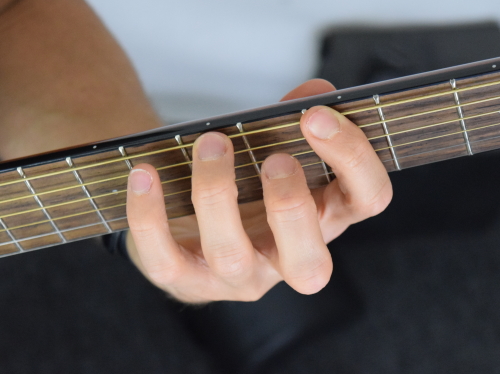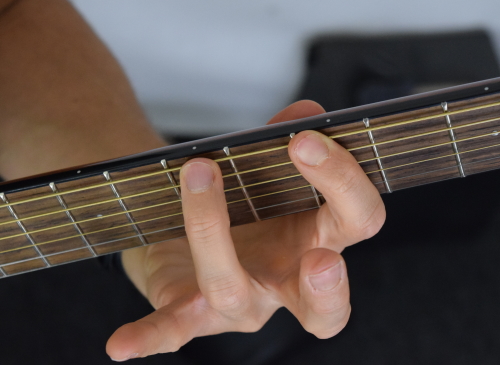There are a lot of things you can fix in your guitar playing with just some small tweaks, but some of these are left out of beginner guitar exercises. There are also a lot of things you can do which don’t yield much gain.
Although not a miracle cure, here is a little eye-opening guitar exercise that will help you if you lack control in your fretting hand fingers.
Try this…
Play the A Major scale as seen below.
Click here if you can’t see the tab.
Run through the scale a few times to get familiar with the notes and watch your fingers as you do so.
Now, play the scale again, but this time…
As you play it, watch what all FOUR fingers are doing and…
Pay close attention to what the fingers that are NOT on the fretboard are doing.
What are these “non-playing” fingers, as I call them, doing?
Are they all staying close to the strings like in this image? (Click here to see the image).
Or are these non-playing fingers moving around and sticking out a mile away from the fretboard like this? (Click here to see the image).
Most guitarists tell me that when I show them this exercise…
This is the first time they have ever thought about or been told to pay any attention to what the “non-playing” fingers are doing.
It is a real eye-opener for them.
When they watch these fingers closely for the first time…
They see that their fretting hand fingers bounce, move, and jump all over the place when not on the fretboard.
That is bad for many reasons – one being, because it shows a lack of control over these fingers.
Two, the further away the fingers are, the longer it takes to return them to the fretboard, and…
Three, the fingers may miss the target fret/string when you do return them as they are so far away. This can cause buzzing or dead notes.
The key is to make sure each finger stays relaxed and close to the fretboard at all times.
Is this hard?
If you are new to the guitar or have developed bad habits from your beginner guitar exercises due to not being taught how to do things properly …
Absolutely, but…
With focus and practice, you can fix and improve these issues and thankfully, because of muscle memory, it doesn’t take too long.
How long depends on how bad the habits are, how much you are willing to try new ideas to fix them, and how diligently you practise.
I have spent years fixing issues like this with real students, many of whom were/are learning later on in life and struggle because of stiff fingers, and sometimes arthritis.
The results are not achieved overnight, of course, but with these techniques, we achieved good, steady changes and progress.
These lessons are in my new guide, Essential Guitar Technique, which is a free bonus available only in my book bundle.
Check it out below and get a whole bunch of other books covering an important variety of essential topics too.
Guitar Domination Super eBook bundle
Dan Thorpe
Guitar Domination
P.S. This post was originally taken from Dan Thorpe’s private email list. To get blog posts like this sent to you which are full of great tips to make fingerpicking, strumming, and learning guitar more enjoyable (especially if you are over 40) join Dan’s list. It’s 100% free, HERE.





Add Comment